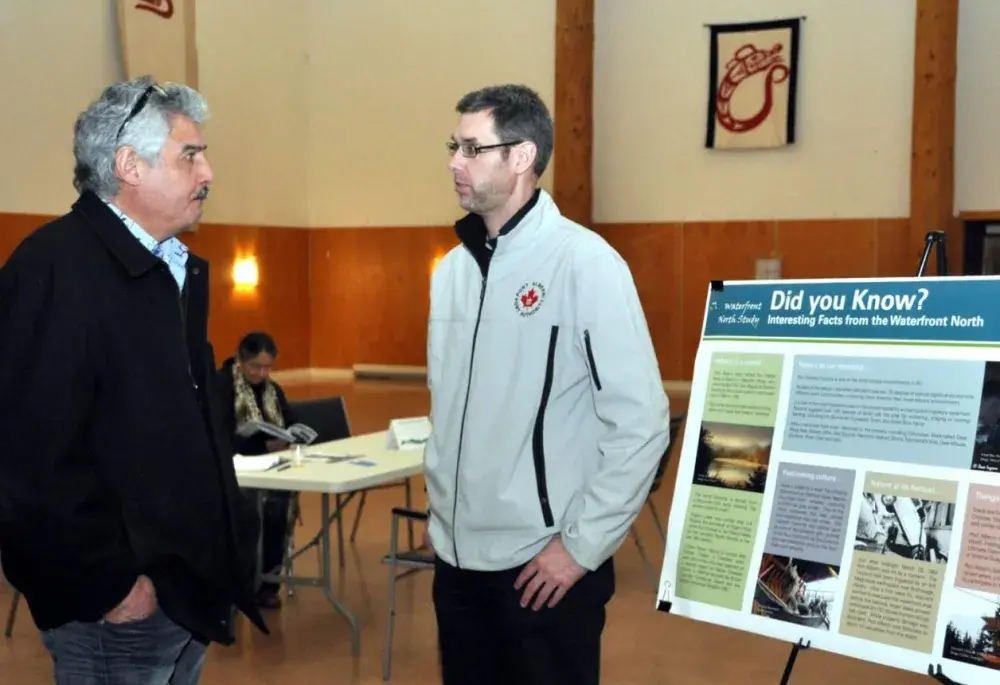Tseshaht and Hupacasath First Nations have partnered with the City of Port Alberni and the Port Alberni Port Authority to create an integrated vision for the North Waterfront area.
The first of two public meetings was held on Feb. 19 at the Hupacasath House of Gathering, with a second event scheduled for Feb. 21 at the Alberni Valley Multiplex.
Billed as an Idea Gathering Public Workshop, the drop-in event was organized to let members of the public meet with consultants and stakeholders and to provide input and suggestions.
The lands in question stretch along both banks of the Somass River and include 25 acres of the Catalyst Paper footprint that have been declared surplus, Victoria Quay, Clutesi Haven Marina, Stirling Field and the city-owned Papermill Dam Park.
The study is being compiled by Nanaimo-based Golder Associates at a cost of $75,000, split three ways between the city, the port and the two First Nations.
Those who attended were asked to fill out a survey and to register their suggestions by putting sticky notes on the site map.
Hupacasath CEO Robert Duncan said his nation wants to move ahead with improvements on its holdings on the Ahahswinis Reserve and the leasehold land at Victoria Quay.
“We have been waiting for this to unfold, to find out what people’s ideas and interests are around development on the waterfront,” Duncan said, adding that increased dialogue is important to gather the best ideas.
At one point, Hupacasath was committed to build a Transformation Centre at Clutesi Haven Marina. Duncan said those plans have been placed on the back burner.
“The funding has gone away from both sources, and they were time-limited as to when they had to start and to be finished,” he said. “When we revisited the business plan, it was difficult to develop a sustainable enterprise there, one that wouldn’t be a drain on the administration. That’s something no one can afford.”
Duncan said while the study itself is a small project, it has created a greater collaboration between stakeholders, and has signaled his nation’s growing status as an economic force in the community.
Hupacasath currently has plans to build a float home development in its traditional territory at Great Central Lake, and is now waiting for final sign-off on the accommodation over the removal of land from Tree Farm License 44.
“It may not be a lot of dollars and cents, but what is contained in there is opportunities, and lots of them,” Duncan said.
With an increased fibre supply in hand, Hupacasath has sawmill equipment on order that is expected to arrive soon.
“The concept is that the construction at Great Central Lake will come from our fibre,” he said.
All told, just 25 people attended the event, with only a handful of First Nations members among them. Port Authority property and public relations manager David McCormick said while the response was somewhat disappointing, it does not mean there isn’t public interest in the study.
“Initially, the participation for public forums can be less than what you hope for. But with the electronic access that is now available, people are able to provide more input from home,” McCormick said.
City planner Scott Smith agreed, noting that public participation is typically light while the initiative is still in the “idea gathering” stage. He predicted a larger turnout when the plan goes to the “design charrette” stage in April. When the draft plan is actually released some time in April, the planner said he expects to see a full house.
“For these meetings, the people who come out are the right people,” he said.
One Hupacasath member who turned out was Diana Evaniuk.
“I would like to see the waterfront left in its natural state, to preserve the natural beauty,” Evaniuk said, adding that there is potential, however, to make improvements away from the shoreline.
“With the marina building gone, it would be nice to have a small eatery there,” Evaniuk said, adding that more seating areas would be desirable.
With the development of a new Harbourtowne Ford dealership on the old Athletic Hall property, marina parking is going to become even more problematic, she suggested.
“It’s a good place for a car lot, just as long as they don’t take up all the parking,” Evaniuk said. “It’s going to get congested.”
Marina overflow boat-and-trailer parking will have to shift further north. Evaniuk said she believes users would not resent paying a reasonable fee for parking if a proper service was developed. But any improvements would require reconfiguration of traffic flows, she added.
That could be tricky, according to Smith.
“At this stage I want to hear everything the public has to say, but you’re not going to change Highway 4,” he said.
That being said, however, Smith said he hopes to receive concrete suggestions for improvements in things like bicycle and pedestrian access along the highway.
Those unable to attend either of the idea gathering workshops are invited to fill in the waterfront survey online on the city Web site at www.portalberni.ca/. Move to the bottom right hand corner of the home page and click the blue Waterfront North Study button, then scroll down to Public Ideas Survey.







